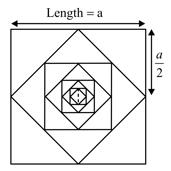MEDIUM
Earn 100
The sum of an infinite geometric series is and sum of its first terms is If the inverse of common ratio is an integer, then which of the following option are correct?
(a)Sum of all possible values of is .
(b)Number of possible values of are .
(c)Numbers of possible values of are .
(d)Number of possible values of are .
50% studentsanswered this correctly
Important Questions on Seeing Structure in Expressions
MEDIUM
Suppose are real numbers such that The maximum possible value of is
MEDIUM
The sum of the and the terms of a is and the product of its first three terms is If the first term of this is positive, then its term is:
MEDIUM
Let be such that and for all natural numbers and If then is equal to
HARD
Let for Suppose are in Arithmetic Progression (A.P.) with the common difference Suppose are in A.P. such that and If and , then
HARD
Let be three non-negative integers such that . The maximum possible value of is
MEDIUM
Three positive numbers form an increasing If the middle term in this is doubled, the new numbers are in Then the common ratio of the is :
MEDIUM
Let and be the and terms respectively of a non-constant A.P. If these are also the three consecutive terms of a G.P., then is equal to:
HARD
The number of real solutions of the equation lying in the interval is____.
(Here, the inverse trigonometric functions assume values in
respectively.)
HARD
Let be the sum of areas of the squares whose sides are parallel to coordinate axes. Let be the sum of areas of the slanted squares as shown in the figure. Then is

MEDIUM
If and be three distinct real numbers in G.P. and then cannot be:
HARD
Let be a non-constant polynomial with real coefficients such that for all real Which of the following statements is NOT necessarily true?
MEDIUM
The sum of the first terms of the series is
MEDIUM
Let be a circle of radius . For let be a circle whose area equals the area of a square inscribed in . Then equals,
MEDIUM
Let , be a complex number, , such that is a real number. Then, the sum is equal to :
MEDIUM
If the and terms of a non-constant arithmetic progression are in geometric progression, then the common ratio of this geometric progression is
MEDIUM
The sum of first terms of the sequence is :
HARD
If is the of two distinct real numbers and and are three geometric means between , then equals
MEDIUM
The sum of the first terms of the series is

